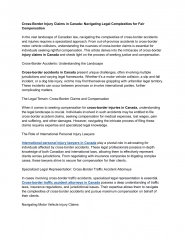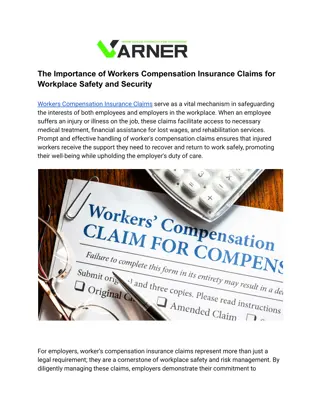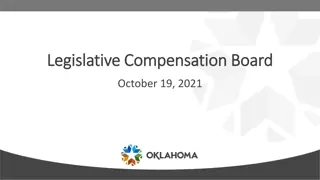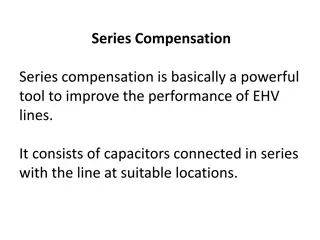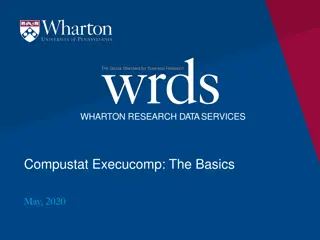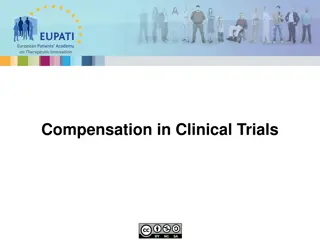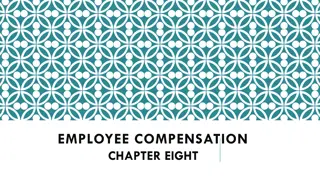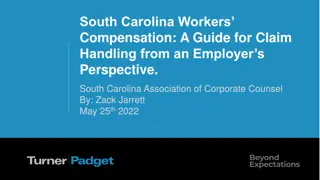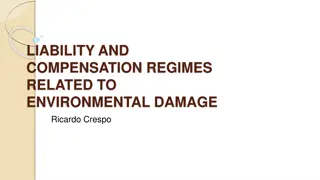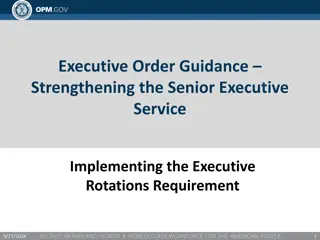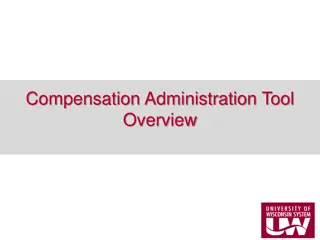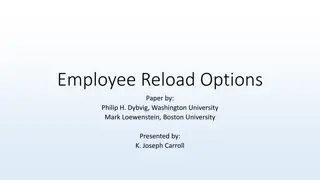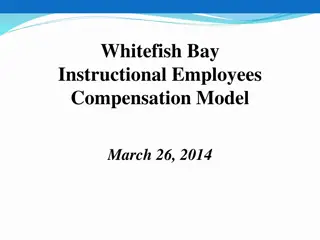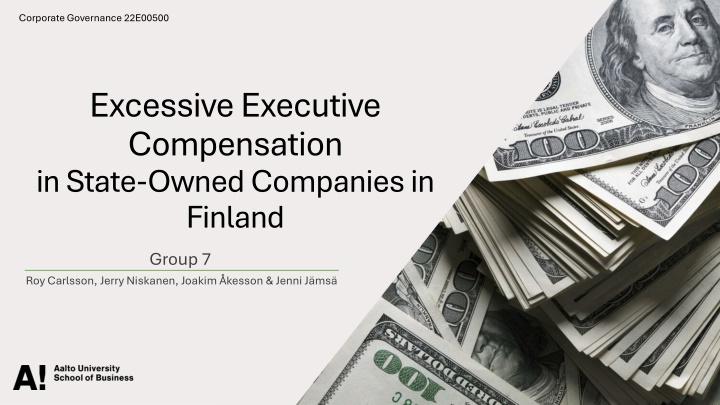
Executive Compensation Trends in State-Owned Companies in Finland
Explore the dynamics of executive compensation in Finnish state-owned firms, analyzing theoretical perspectives, empirical findings, and the development of CEO pay over time. The study delves into issues of excessive compensation, agency theory, managerial power, and market-based explanations. Understand the shifts in CEO pay pre- and post-crisis, the impact of performance metrics on payouts, and the growing CEO-to-worker pay gap.
Download Presentation

Please find below an Image/Link to download the presentation.
The content on the website is provided AS IS for your information and personal use only. It may not be sold, licensed, or shared on other websites without obtaining consent from the author. If you encounter any issues during the download, it is possible that the publisher has removed the file from their server.
You are allowed to download the files provided on this website for personal or commercial use, subject to the condition that they are used lawfully. All files are the property of their respective owners.
The content on the website is provided AS IS for your information and personal use only. It may not be sold, licensed, or shared on other websites without obtaining consent from the author.
E N D
Presentation Transcript
Corporate Governance 22E00500 Excessive Executive Compensation in State-OwnedCompaniesin Finland Group 7 Roy Carlsson, Jerry Niskanen, Joakim kesson & Jenni J ms
Agenda Introduction 1 Theoretical Perspectives 2 Empirical Analysis 3 Discussion 4 Conclusion 5
Excessive Executive Compensation Excessive Executive Excessive Executive Compensation Compensation Executive compensation compensation 1 2 Managers influence vs. arm s length contracting Pay-to-performance Cultural norms Costs vs. Incentives Arm s length contracting 3 4 5 References: Bebchuk & Fried (2005)
Theoretical Perspectives Agency Theory Conflict of interest between management (agents) and shareholders (principals). Managerial Power Theory Managers power allows them to shape their compensation to their favour. 1 . . 2 3 4 Tournament Theory High CEO pay as motivation for managers to compete in a tournament for top positions. 5 . References: Van Essen et al. (2015), Chen et al. (2011)
CEO Compensation Development Over Time Pre-Crisis Development (2000-2008) o Shift towards higher base salaries, substantial bonuses, and stock options. o Compensation packages designed to align executives' interests with shareholders through performance-based incentives. Issues with mismeasurement of performance metrics, leading to erroneously high payouts. Top executives cashed out large amounts of performance-based compensation not clawed back after the firms collapsed. 1 2 3 Post-Crisis Development (2009-2023) o Increased scrutiny of CEO compensation packages o Demand for accountability and stronger pay-performance linkage o Dodd-Frank Act, clawback provisions, and o Fairness, transparency, and alignment with long-term interests and shareholder expectations. 4 5 CEO compensation has bounced back, and CEO-to-worker pay gap has grown. References: Bebchuk et al. (2011), Fried and Shilon (2011), Sepe (2011), API (2023)
CEO Compensation Development in Finland Pre-Crisis Trend o Modest decline in CEO compensation while a significant increase in firm size (1975-1991). o By 2005 notable jump in compensation and growth in firm size. Year Average CEO pay Average Firm Revenue 1 1975 483 300,00 996 159 701,00 2 3 1991 425 431,00 3 216 047 649,00 Post Crisis Trend o CEO compensation continued to rise, peaking in 2016. o Resilience and growth despite revenue challenges. 4 2005 3 658 501,00 12 772 163 432,00 5 2016 4 404 452,00 8 745 124 935,00 Market-Based Theory explains CEO compensation development well from the mid- 90s onwards. 2018 3 768 608,00 8 935 459 004,00 References: Rosenblum (2024)
Recent CEO Compensation in Finland CEO Compensation in Finland 2019-2023 CEO compensation in Finnish companies listed on Nasdaq Helsinki has been steadily increasing. 1,200,000 1,000,000 800,000 Notable decrease in the CEO compensation-to- sales ratio over the period. 600,000 1 400,000 200,000 Companies have become more efficient, generating higher revenues without proportionately increasing CEO costs. 2 0 2019 2020 2021 2022 2023 3 Average CEO compensation Median CEO compensation 4 CEO Compensation / Sales in Finland 2019-2023 Decreased compensation-to-sales ratio may suggest that firms are aligning CEO incentives more closely with company performance and shareholder value. 1.6 % 5 1.4 % 1.2 % 1.0 % 0.8 % 0.6 % Median CEO compensation-to-sales ratio indicating most firms maintained a balanced approach to CEO compensation. 0.4 % 0.2 % 0.0 % 2019 2020 2021 2022 2023 Average CEO /Sales Median CEO / Sales References: Annual & Remuneration Reports
Cases of potentially excessive compensation: Fortum In 2022, consumers were struggling with high energy prices, and the Unipersituation was beginning to unravel. The Uniperdeal was widely criticized at almost every stage. In the midst of this, CEO Markus Rauramo was paid over 2.5 million EUR in 2022. Fortum needed a rescue package from the government amounting to roughly 6 billion EUR. As a condition of the loan, executives wouldn t receive any incentives for two years. The board still agreed on a package based on 2021 performance, disregarding 2022. Executives decided to voluntarily forgo the compensation once it became public. 1 2 3 4 5 In 2022 The Finnish government decided that municipality-owned energy companies executive incentive plans should be set as sustainable according to the current situation References: Helsingin Sanomat, 2023
Cases of potentially excessive compensation: Finnair Airlines were among the hardest-hit industries during the start of the pandemic, essentially surviving on government subsidies in 2020 and 2021. 1 In the midst of this, CEO Topi Manner s compensation grew compared to the previous year in 2020, up to roughly 1.1 million EUR. Simultaneously, most of Finnair s employees were temporarily laid off. 2 3 4 5 The compensation was based on 2019 performance, but the timing still raised some eyebrows. References: Helsingin Sanomat, 2021
Media and thepublic opinion on executive compensation Company performance Media has the power to act in the monitoring role. Media has raised especially many cases of state-owned companies and their remuneration. The spark for media interest in CEO compensation was ignited during the recession in the 1990s. Our analysis has shown that the following matters affect how the public sees execution compensation levels. Weak company performance and high salary raises for CEO 1 Dissatisfaction towards company services 2 High prices, low customer satisfaction, poor quality etc. 3 4 Temporary or permanent layoffs 5 Generally seen as not fair not one of the team Wage moderation time period Low salary increases for employees for a decade References: Vittaniemi (1997), Liljeblom and L flund (2006)
What constitutes excessive compensation? 1 2 3 4. 5 1 2 3 4 Compensatio n doesn t follow company performance 5 Dissatisfied shareholders Myopic behavior Media coverage Dissatisfied employees
Were our cases examples of excessive executive compensation? Fortum: Finnair: Poor performance was followed by high compensation & bonuses The government and the public were forced to come in and essentially bail the company out. Executives were meant to receive bonuses in contradiction to the loan conditions, executives tried to get away with it and were caught. Verdict: A case of excessive executive compensation The pay was based on the previous year s performance, and the company was in trouble due to a black swan event. Manner voluntarily cut his salary for 6 months by 15 %. Manner s salary (1.1mEUR) is also relatively modest compared to other cases. Finnair quickly bounced back after the pandemic, despite added problems caused by the war in Ukraine. Verdict: Not a case of excessive executive compensation 1 2 3 4 5
Key takeaways CEO compensation has changed drastically over the years both in size and structure, with a shift towards more stock-based compensation and higher salaries. 1 2 What constitutes excessive compensation depends on many factors, with company performance being chief among them. Even very high salaries or CEO/Employee pay ratios can be justified, if it s representative of company performance. 3 4 5 The media and public opinion always play a role in cases of excessive compensation, both in determining them and in the aftermath.
References American Policy Institute (2023): https://www.epi.org/publication/ceo-pay-in-2022/ Bebchuk, L. A., & Fried, J. M. (2005). Pay Without Performance: Overview of the Issues. Journal of Applied Corporate Finance, 17(4), 8 23. https://doi.org/10.1111/j.1745-6622.2005.00056.x Bebchuk, L. A., Cohen, A. & Spamann, H. (2009). The Wages of Failure: Executive Compensation at Bear Stearns and Lehman 2000-2008. Yale Journal on Regulation, Vol. 27, 2010, 257-282. https://papers.ssrn.com/sol3/papers.cfm?abstract_id=1513522 Chen, J., Ezzamel, M., & Cai, Z. (2011). Managerial power theory, tournament theory, and executive pay in China. Journal of corporate finance, 17(4), 1176-1199. Fried, J., Shilon, N. (2011). Excess-Pay Clawbacks. Journal of Corporation Law, 36(4), 722-751. Liljeblom, E., & L flund, A. (2006). Developments in corporate governance in Finland. International Journal of Disclosure and Governance, 3(4), 277-287. Rosenblum, J. (2024). Politics, markets, and CEO pay: a congruence analysis of two competing theoretical explanations of executive compensation at large firms in Finland. Quality & Quantity, 58(1), 413-444. Sepe, S. (2011). Making Sense of Executive Compensation. 36 Delaware Journal of Corporate Law 189. Arizona Legal Studies Discussion Paper No. 10-42. https://ssrn.com/abstract=1721131 van Essen, M., Otten, J., & Carberry, E. J. (2015). Assessing Managerial Power Theory: A Meta-Analytic Approach to Understanding the Determinants of CEO Compensation. Journal of Management, 41(1), 164 202. https://doi.org/10.1177/0149206311429378 Vittaniemi, J. (1997). Top executive compensation and company performance in Finland.

